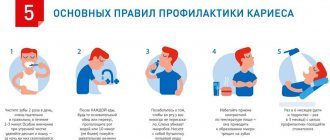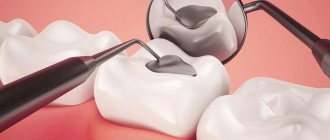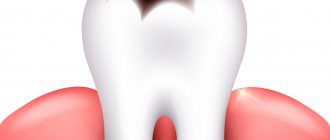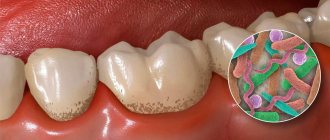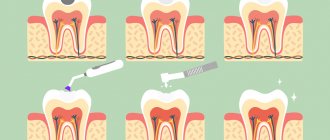In this article
- In what cases does dental caries develop: risk factors
- Prevention of dental caries: primary, secondary and tertiary
- Methods of primary prevention of caries
- The role of nutrition in preventing dental caries
- How to reduce the adverse effects of carbohydrates on teeth
- Strengthening the immune system and reducing stress factors as methods for preventing dental caries
- Drug prophylaxis
- Sealing dental fissures as caries prevention
- Personal oral hygiene as protection against caries
- How to brush your teeth correctly to avoid caries?
- Chewing gums as caries prevention
According to official statistics from the World Health Organization, almost 100% of the world's population has dental caries. Modern dentistry offers effective methods for treating this disease, but prevention plays the most important role in preventing caries.
In what cases does dental caries develop: risk factors
The condition of teeth is one of the main indicators of the overall health of the human body. Therefore, preventive measures aimed at reducing the risk of caries development are an important element of comprehensive health improvement. To protect teeth from carious lesions, it is necessary to understand what contributes to the development of the disease.
There are three main risk factors:
- dental plaque and the microbes it contains;
- increased amount of sugar in food;
- lack of fluoride in food and water.
In addition to these main factors in the development of caries, to varying degrees, the risk of pathology may depend on the level of solar radiation, gender and age, climatic and geographical living conditions. The likelihood of illness increases with pathological pregnancies, systemic and acute infectious diseases, during radiotherapy and other influences that weaken the immune system. An important risk factor is insufficient or improper dental and oral hygiene.
Comprehensive prevention of caries in adults involves influencing the main risk factors using different methods. Thanks to such preventive measures, it is possible to eliminate or reduce the risk of developing dental caries.
Prevention of dental caries: primary, secondary and tertiary
In modern dentistry, there are three important stages of caries prevention. Primary prevention helps prevent the development of dental caries. It involves performing procedures that eliminate the factors and causes that provoke the disease. Secondary allows you to detect the disease at an early stage and take measures that will stop its development and prevent its reappearance. Tertiary is a set of measures after the main treatment. It can be aimed at restoring dentition, chewing function, or the lost appearance of teeth.
Causes of caries
The main reason for tooth damage by cariogenic bacteria is their penetration into the tooth tissue due to demineralization of the enamel. This is caused by a decrease in pH below 4.5. There could be a variety of reasons for this:
- Lack of proper oral hygiene.
- Deficiency of minerals supplied with water and food.
- Abuse of fast carbohydrates.
- Features of the anatomical structure of teeth.
- Genetic factors.
- Chemical composition of saliva.
Methods of so-called primary prevention are aimed at preventing the occurrence of caries, which are relevant precisely during the period when there are no visible lesions on the teeth. This differs from secondary prevention, which consists of treating caries and its complications. Primary prevention can be endogenous (general) and exogenous (local).
Methods of primary prevention of caries
They are divided into endogenous (impact on internal factors) and exogenous (impact directly on the tooth surface).
Endogenous prevention measures include:
- complete, balanced, varied diet;
- activities aimed at strengthening the immune system;
- elimination of stress factors;
- taking vitamin and mineral supplements and saturating the body with fluoride, calcium and other microelements necessary for dental health.
Exogenous prevention of caries is:
- brushing your teeth daily using a good toothbrush, toothpaste and floss;
- professional cleaning by a dentist twice a year;
- treatment of tooth enamel with preparations containing fluoride;
- limited consumption of sweets and other foods rich in carbohydrates;
- use of chewing gum;
- sealing fissures (natural pits and grooves) on children's teeth.
Comprehensive caries prevention measures help reduce the likelihood of its occurrence several times.
Do I need a dental scan?
American dentists recommend having your teeth x-rayed every year. Austin Frakt, a health economist, reviewed[] medical studies and concluded that such reinsurance is unwarranted. Cavities in the tooth form more slowly—over 2–3 years.
In Russia, preventive x-rays are not so popular. But computed tomography is suggested to be done regularly. You should also not agree to this expensive service more often than once every couple of years.
The role of nutrition in preventing dental caries
One of the effective measures to combat caries is the correct approach to nutrition. The tissues of the oral cavity are sensitive to the lack of certain food components. In particular, a lack of protein in the diet prevents the accumulation of calcium and disrupts the structure and strength of enamel. At the same time, foods that are too fatty increase the permeability of the enamel, which increases the likelihood of the formation of carious lesions.
An excess of refined carbohydrates (sweets, flour products, sugar) in the diet not only reduces the resistance of teeth to the development of caries, but also weakens the immune defense, which is also a risk factor.
To prevent caries, it is important to adhere to the following dietary recommendations:
- A sufficient amount of protein must be present in the daily diet;
- eat foods containing vitamins C, D and group B;
- be sure to eat foods rich in calcium and phosphorus (milk, cheese, eggs, fish, broccoli, legumes), as well as fluoride-containing foods (sea fish, Georgian tea);
- it is necessary to limit the consumption of foods rich in “fast” carbohydrates, eat as little sweets, cakes and refined sugar as possible;
- Avoid sticky products: they can remain on the surface of tooth enamel for up to an hour, contributing to its demineralization for a long time.
The nature of your diet directly affects the condition of your teeth. A rational, fortified, balanced diet is an effective method of non-drug prevention of caries.
How to reduce the adverse effects of carbohydrates on teeth
Fermentation of carbohydrates under the influence of microbes leads to the production of organic acid, which destroys tooth enamel and contributes to the development of caries. It is impossible to completely stop eating carbohydrates, but it is quite possible to reduce the intensity of their influence on the development of caries. The following measures will help with this:
- Reducing the amount and, most importantly, the frequency of eating carbohydrate foods, so that the teeth come into contact with carbohydrates as little as possible.
- In some cases, your doctor may recommend switching from sugar to sweetener substitutes.
- Reducing the time carbohydrates spend in the mouth. This can be achieved in two ways: do not eat the sweet dish last, and be sure to rinse your mouth after eating.
- Avoid eating sweets at night and between meals.
If any of the recommendations are violated, to reduce the risk of caries, you need to brush your teeth and rinse your mouth.
Stopping the development of caries
It is advisable to stop the development of caries at the earliest possible stage: in this case, the disease will be much easier to treat.
At the initial stage, caries looks like a small spot. At this stage of development, it can be coated with a special gel that can restore damaged enamel. If you see a doctor on time, you may be able to do without the preparation procedure, which is, of course, completely painless.
If you start the development of caries, you will have to resort to drilling, and if the pulp is affected, this can add additional painful sensations.
In addition, ignoring caries is fraught with:
- destruction of the affected tooth and, as a result, expensive installation of an implant;
- indigestion, since the affected teeth cannot fully cope with the chewing function;
- aesthetic inconveniences.
Strengthening the immune system and reducing stress factors as methods for preventing dental caries
The most important task of the immune system is to resist the effects of microbes. If the body's defenses are weakened (including under the influence of stress), the immune system cannot resist harmful bacteria. That is why, against the background of severe stress and weakened immunity, the risk of dental caries increases.
Prevention consists of strengthening the immune system, for which the following measures are suitable:
- quality sleep of at least 8 hours;
- physical activity: daily exercise, sports;
- hardening: water procedures, sun and air baths, cool air in the apartment;
- avoidance of stressful situations;
- refusal or limitation of bad habits (smoking, alcohol);
- adherence to daily routine;
- if necessary and only as prescribed by a doctor, medications to strengthen the immune system.
Drug prophylaxis
After an in-person examination, the dentist, according to indications, may prescribe the patient one of the following methods of medicinal endogenous prophylaxis:
- additional fluoridation of food and drinking water (the amount of fluoride is calculated only by a doctor, taking into account the dose that a person already receives from food and water);
- anti-caries drugs for oral administration (usually they contain a complex of vitamins and sodium fluoride that help strengthen teeth).
There are also exogenous methods of drug prophylaxis. These include coating the teeth with fluoride varnish or fluoride gel. Fluoride varnish stays on the enamel surface for a long time, saturates it with fluoride ions, has an antimicrobial effect, and reduces pain in cases of increased tooth sensitivity. Fluoride-containing gel has a remineralizing effect on tooth enamel; it is used for applications or electrophoresis.
Sealing dental fissures as caries prevention
Fissures are natural depressions on the surface of teeth. Food debris accumulates in these pits, making it more difficult to remove plaque and germs from there during cleaning. In addition, in the fissure area, enamel mineralization is slowed down; its layer is thinner than on other surfaces of the teeth, so natural depressions are considered a risk zone for the development of carious lesions. The fissure sealing method is primarily used for children. Its essence lies in the fact that the recesses are closed with special sealants. As a result, food does not accumulate on the teeth, and the vulnerable spot of the tooth surface is reliably protected from the action of pathological microorganisms.
Preventive measures available to children
To prevent the child from encountering caries of newly erupted permanent units, their fissures are sealed. To do this, the chewing surface of the molars is coated with a special protective composition that resembles filling material in appearance. It serves as a kind of shield between the enamel and food debris. Thus, it prevents caries from occurring.
Sealing should be carried out as soon as possible after the permanent unit has erupted. Only then will it be effective.
The issue of caries prevention should be discussed with your doctor. He will assess the condition of your teeth and suggest a method that will be optimal specifically for your situation. Remember: you need to visit a dental clinic not only when toothache haunts you - it is better to do this every year for a preventive examination.
Personal oral hygiene as protection against caries
Individual oral hygiene plays an important role in preventing caries. It refers to exogenous non-drug methods of prevention.
Regular brushing of teeth, tongue, removal of food debris, soft deposits contributes to the proper development and functioning of tooth enamel. The components of therapeutic and prophylactic pastes enrich the tissues of the oral cavity with calcium and phosphate salts, vitamins and microelements, making them more resistant to negative influences. Massaging the gums with a toothbrush activates metabolism, improves blood circulation in periodontal tissues, and prevents bleeding and gum disease.
Personal hygiene involves careful independent removal of plaque from the surface of teeth and gums using toothbrushes, pastes and other products.
The effectiveness of individual oral hygiene depends on several factors:
- quality and compliance of the characteristics of the toothbrush with the condition of the teeth of a particular patient;
- following proper cleaning techniques;
- the use of additional cleansing methods - irrigators, dental floss, mono-beam and orthodontic brushes, rinses.
How to brush your teeth correctly to avoid caries?
The toothbrush should have a small head to easily penetrate hard-to-reach areas of the oral cavity, removing plaque even from distant teeth and from interdental spaces. The stiffness of the bristles is of great importance. The best choice for most adult users is a medium-hard brush. It will clean the surface of the teeth quite intensively, without damaging the gums or scratching the enamel.
However, for children and those with sensitive teeth and gums, brushes with soft bristles are needed. Regarding the correct choice of the optimal toothbrush, as well as toothpaste with the appropriate composition, it is better to consult with your dentist. He will be able to make recommendations based on an in-person examination of the oral cavity.
Even a properly selected brush and good toothpaste will not protect against caries if you brush your teeth incorrectly. Therefore, it is important to learn a technique that will allow you to most effectively clean your teeth and oral cavity from bacteria. There are several different ways to clean teeth in dentistry. One of the widely used is the standard Pakhomov method:
- The dentition is conventionally divided into segments.
- Begin cleaning from the upper right segment, from the distant chewing teeth. They alternately move from segment to segment along the upper jaw, and then move on to cleaning the lower row of teeth in a similar way.
- According to Pakhomov’s method, when cleaning the lateral front and back surfaces of the teeth, the brush moves in the direction from the gums to the edge of the tooth. Chewing surfaces are cleaned with back-and-forth movements.
- Finish cleaning with circular movements in each segment.
Please note that this cleaning method is suitable for those who use regular manual toothbrushes. There are nuances in using electric toothbrushes, and the method of using them is always detailed in the instructions. The main difference is that an electric toothbrush does not require mechanical movements; it simply needs to be moved from tooth to tooth without applying too much pressure.
After brushing your teeth with a brush and toothpaste, it is recommended to additionally clean the interdental spaces with floss or irrigator, and also use the mouthwash as a solution for the prevention of caries.
Why do you need interdental brushes?
In 2015, a review of seven studies was published in which 354 patients brushed their teeth in three ways:
- only with a brush;
- brush and floss;
- brush and brushes.
Only once did scientists note that additional cleaning with a brush had advantages over brushing. But the evidence cannot be considered rigorous, since we are talking about a superficial study: the effect has not been analyzed in the long term. The same goes for comparing brushes and dental floss.
There is not enough data yet to draw conclusions about the benefits of brushes for interdental spaces.
Chewing gums as caries prevention
Chewing gum may help prevent tooth decay by increasing saliva production. Salivary fluid washes each tooth, removing dirt and germs from it, has an antiseptic effect on the oral cavity, and neutralizes plaque acids. For preventive purposes, it is recommended to chew gum with sweeteners for several minutes after each meal, especially sweets. Remember that comprehensive preventive measures will help maintain the health and appearance of your teeth for a long time.
Nutrition rules
One of the ways to prevent caries is proper nutrition. Dentists give the following general recommendations:
- limiting the consumption of sweets. It is better to replace confectionery and chocolate with dried fruits and honey; soda - compotes. It is important to know when to stop and not eat too many carbohydrates, and rinse your mouth after each meal;
- balanced diet. In order for the hard tissues of the tooth to receive the required amount of minerals, the menu should include fermented milk products, cheese, fresh herbs, nuts, meat, and lean fish;
- eating solid foods. Apples, carrots, and other tough fresh vegetables and fruits are not only healthy, but also mechanically clean the enamel, stimulate blood circulation in the gums, which helps maintain oral health;
- careful attention to the temperature of food and drinks. It is better not to eat extremely hot or cold foods, and especially not to alternate between them. Otherwise, the enamel may not withstand it - it may become covered with microcracks, and this contributes to the accumulation of plaque and the proliferation of bacteria;
- careful consumption of solid foods. It is better to eat nuts and other extremely hard foods carefully, making sure that particles do not get stuck in the interdental spaces and fissures.
